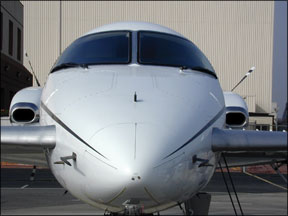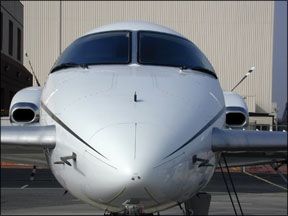Its a myth that good pilots can “fly anything with wings.” The truly good pilot realizes each type of airplane has unique characteristics and systems. Understanding them is the difference between “flying” and “flying safely” in an 288 unfamiliar aircraft type. In some cases, the need for transition training is spelled out whether in the form of endorsements or ratings required by the FAA or its foreign equivalent, or as a stated condition for coverage under an aviation insurance policy. When FARs or insurance companies tell us precisely what we must do to act as pilot-in-command of an airplane type new to us, its usually easy to find an instructor and complete the training. When there is not a clear-cut series of tasks we must complete in the new airplane type, however, its really up to us to design a transition training program. Mapping out the transition Its extremely common to see an insurance policy for the pilot new to an aircraft type to include language like this: “The pilot must log 10 hours dual instruction with a certificated flight instructor meeting the requirements of this policy prior to coverage as pilot-in-command….” There is almost never any amplification in the policy as to what needs to be covered during this transition. It may be tempting to do a few turns around the pattern, then fly a couple of easy cross-country trips with the instructor to finish up the 10 hours requirement. Although there is great value in cross-country experience, especially when learning new avionics or engine management skills, I think the transitioning pilots best interests (and the insurance carriers, also) are served by mapping out a precise transitional syllabus to make effective use of the required time. For instance, Ive done a number of tailwheel transitions where the insurance company required the pilot get 10 hours of dual instruction before coverage as pilot-in-command. In most cases, the transitioning tailwheel pilot is already qualified to fly light airplanes (there are exceptions see the sidebar on page 10). If thats the case, the best use of that 10 hours dual is to hone in on the unique characteristics of tailwheel airplanes that make the FAA require an instructor endorsement and the insurance company stipulate a dual instruction requirement in the first place. Briefing such a student before beginning the transition training, Id propose: Taxi and ground maneuvering to proficiency, including on pavement and in wind; High-speed taxi (down the runway) for practice in the takeoff and landing rolls, including in winds; Basic airwork maneuvers from the Practical Test Standards, with emphasis on rudder coordination (which usually requires more work in tailwheel designs); Three-point and wheel landings (consistent with manufacturer recommendations); “Lost” procedures from typical tailwheel airplane cruise altitudes and using the equipment on board the airplane; and, Stalls, engine failures, hand-propping (if not equipped with a starter) and grass-field operations. The big surprise for most of my tailwheel students is that I have a goal, in that 10-hour period, to log at least 50 takeoffs and full-stop landings. No “10-hours-delivering-the-airplane-to-its-new-home” checkouts from me. My suggestion and I think the insurance companys intent is to spend the time learning techniques to avoid the most common causes of mishaps. In tailwheel airplanes, that means taxi, takeoff, landing, wind correction, rudder coordination and dealing with deteriorating weather. Similarly, transition to a retractable-gear airplane should include many takeoffs and landings to instill new habit patterns for gear operation and verification, some with distractions and unusual situations that often contribute to retractable-gear accidents (see “Neither Down nor Locked,” 
Retractable pilots need to be comfortable with type-specific emergency gear extension procedures, including actual in-flight practice extending the gear manually unless there is a specific manufacturers recommendation against practice manual extensions.
Pilots transitioning to a new-to-them type of multiengine airplane should review engine-out scenarios, to the extent they can be safely simulated in flight, the intricacies of sometimes complicated fuel and electrical systems, and unique items like heater and ventilation controls.
Pilots of all types should be thoroughly familiar with at least the basics of the avionics on board the airplane before the end of transition training, and especially all modes of autopilot and flight director if installed including trim runaways, system failures that affect the autopilot and all methods of manually disconnecting the autopilot. Turbocharging, oxygen systems, pressurization, and other aircraft systems all demand thorough familiarity and practice also. It may be hard to get everything done in only 10 hours of instruction…so train to proficiency, even if it takes a little longer, and not just to insurance requirements.
Are You A Good Risk?
Weve been focusing on the transition plan as a means of meeting the checkout requirements of an aircraft insurance policy. What many do not realize is that a written transition plan may also be a great tool for you if you do not yet meet the usual, minimum requirements for coverage for the airplane type at all.
You can “sell the underwriter” on you as a good risk. From an underwriters standpoint, a “risk” is a combination of pilot, aircraft and operating environment (VFR vs. IFR, Part 61 vs. Part 135, etc.). Most insurers have stated minimum pilot experience requirements for coverage in various classes of aircraft, like retractable gear, or tailwheel or value greater than $250,000, etc. You may be able to get in under the wire if you present a good plan for transitioning into the type before acting as pilot-in-command.
Here, a good insurance agent is your best friend. He or she will need to enthusiastically take your application to insurance underwriters, even though you dont meet the minimum requirements, and convince them that despite your experience you are a good risk. Your agent quite likely, if asked (nicely), will help you develop a written transition plan highlighting what youve done to date and what you will do once the policy is written, a transition plan that will become a legally binding part of your insurance contract.
An established track record of making an extra effort to be safe FAA WINGS or FAASTeam training, AOPAs online training courses, etc. may present you as a better risk than underwriters minimum criteria assume.
The transition instructor
Most pilots become very attached and loyal to their instructor. Its natural to idolize the person who introduced you to the skies. When planning a transition, however, take an objective look at your instructors capabilities and background. It may be that, expert as he/she is in some areas of flying, your local CFI might not be your best choice for transitioning into a new type of airplane.
To some extent, insurance people make this decision for you. Look at the sample policy requirement earlier in this article and youll see the phrase, “with a certificated flight instructor meeting the requirements of this policy.” In most cases for the instruction to count toward checkout requirements, the instructor must have a certain amount of experience in that type of airplane. Usually the instructor must meet the policys Open Pilot Warranty (OPW), which among other things, includes (typically) 25 hours logged time as pilot-in-command of that make and model of airplane. In advanced types (for instance, pressurized airplanes) the OPW includes successfully completion of factory-authorized training in the type.
Before you plan to fly with your local CFI check to see if he/she
Meets the instructor requirements of the insurance policy;
Acknowledges that, even among different models of the same airplane, that there are often significant differences that affect safe operation;
Is conversant with the intricacies of the specific airplane, including avionics and add-ons like tip tanks, etc.;
Will work with you to develop a syllabus for your transition training; and,
Will spend ground as well as flight time with you until you fully understand the airplane and its systems.
If the answer to all is “yes,” then great…youve found yourself a transition instructor. Chances are, though, that the CFI that so ably teaches primary flight in a Piper Warrior might not have the experience to aptly teach you how to fly a Piper Mirage. Or the instructor who owns and flies a 1978 V35B Bonanza may not know enough about the pressure-carb engine of a 1955 F35 Bonanza to teach you how to run it. Especially where avionics is concerned, you may find you need to work with more than one instructor to get fully checked out in your airplane!
Roll your own
If you cant find the right instructor, or cant afford the tuition and travel expense to go to a specialist, you may have to “roll your own” transition-training CFI. Find the instructor who most closely fits the criteria for choosing a local transition instructor usually its time-in-type or experience with unusual modifications that limits an otherwise superb CFI. Talk to him/her to see if he/she is willing to do some research to get up to speed on these items.
If the provisions of your insurance policy require the instructor to meet the OPW or other criteria, youll have to do this sales job to the underwriters as well. Get a signed statement from the CFI youd like to use listing his/her experience, time in similarly-configured airplanes (for example, retractable gear or tailwheel) and especially in airplanes as similar as possible to yours.
For example, its going to be almost impossible to find a CFI who meets the OPW for a Navion. You may be able to find one, however, with experience in early 1940s Bonanzas that share that eras approach to aircraft systems and layout. Contact your agent or broker and explain the situation, sending the CFIs statement.
Your agent/broker should forward your request to the insurance underwriters and, if they agree that a fully qualified instructor is not available to you, they may revise the policy to require an instructor “meeting the requirements of this policy OR (instructor name), a CFI having XX total hours including XX hours in retractable gear airplanes and XX hours in 1940s Beech Bonanzas….” Now you can fly your transition plan with your selected instructor.
Transition?
As the name implies, a “transition” is more than a simple checkout in an airplane type thats new to you. A transition is a planned process to take you from what you know and do now, to become a pilot thoroughly familiar with and competent in that “new” aircraft.
The goal should not be to meet the minimum requirements, or to finish a checkout for the least possible cost, but instead to devote the time and money necessary to kick off a long, enjoyable and safe piloting experience.
In some cases the FAA demands it and insurance companies require it, but all pilots should consider a quality transition a vital part of being safe in any unfamiliar aircraft.




